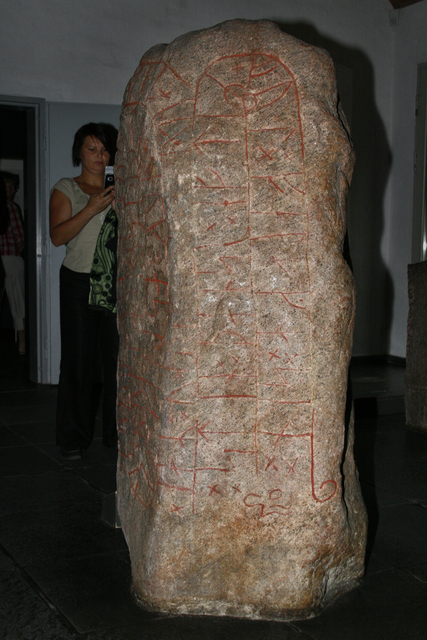"Rune stones in the Ǻrhus area
Five rune stones were found in Ǻrhus itself. Add to this one from Egå, one from Vejlby, and one from Hørning south of Ǻrhus. The Egå stone is now in the National Museum in Copenhagen, whereas the others are exhibited in the rune hall of this museum. The rune stones are from c. 975-1025.
The rune stones from the town of Ǻrhus
As most other rune stones, the five stones from Ǻrhus were reused after the Viking Age, and so their original location is unknown. One was fund incorporated in a flight of steps by Ǻrhus Karedralskole (the cathedral school). The inscription reveals that it used to be part of a stone setting, as it reads "Esger Bj... these stones". The rest of the stones from Ǻrhus were found in buildings adjoining the important road to Ǻrhus from the south, today called Vestergade, which may be their original location. The famous mask stone was found underneath a watermill.
The rune stones from the roads leading to the town
The Vejlby stone was mentioned in a written source already in the 17th century. It was then situated next to an almost levelled [sic] burial mound next to the road between Randers and Ǻrhus. The Egå stone was found around 1814 near the Brobjergbakke hill by Gl. Egå Bro (the old Egå bridge), probably in its original position next to the old ford north of Ǻrhus. The Hørning stone was found in 1849 next to the Bering Bro bridge, approximately 12 km southwest of Ǻrhus, next to the old road between Jelling and Ǻrhus.
Paganism and Christianity
The rune stones can be decorated with both pagan and Christian symbols, and not surprisingly, the Christian symbols such as crosses are usually found on the younger stones. However, religious expressions are rare on Danish rune stones. The meaning of the mask on the largest of the rune stones from Ǻrhus is unknown. It may be a symbol meant to avert evil."
It should be noted that all paint seen on these stones (and any rune stones in my photos thus far actually) is not original, but is only a guess at how the stones may have historically been decorated.
Reacties
 Reactie toevoegen
Reactie toevoegen
Log in om een reactie te plaatsen!



